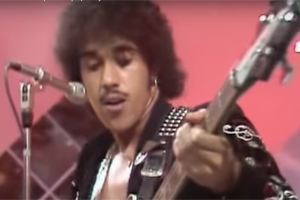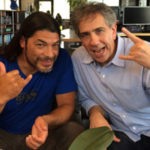FBPO’s Top 12 list of bass players who also led the band
By Gary Graff, Contributing Editor
August 11, 2014
Any bass player will tell you that their primary role is support. They’re the foundation of the ensemble. The rock. Whether they’re bringing the funk or driving the groove, locking in with the drummer or playing in counterpoint, bassists are most often called on to be present, but not necessarily out front.
But sometimes the bottom = the top. Or at least the front. The lead-singing bass player is a relative rarity and we all know how hard it is to do both well. But those exceptions have been standouts, some of the most pivotal figures in music, period, not just bass playing. With that in mind, here’s our choice of the Top 12 artists who have effectively added some vocal cord action to their four (or more) strings over the years…
Paul McCartney
The king, of course. When we heard him belt out “I Saw Her Standing There” over some high-speed action on the fret board, we knew Macca was a man who could multi-task with impressive abandon. He hasn’t let us down since and has capably maintained his good form on both fronts.
Jack Bruce
A virtuoso on the bass and a rich tenor at the mic, Bruce released his first solo single (“I’m Getting Tired”) in 1965, but came into his own with Cream, co-writing and singing signature songs, such as “White Room,” “I Feel Free” and “Sunshine of Your Love.” That would be enough to insure his legacy, but don’t discount his subsequent work with West, Bruce & Laing, BLT with Robin Trower and his solo catalog, including this year’s Silver Rails.
Chris Squire
The Yes man is inarguably among those who created a new vocabulary for using the bass in rock music, but it was his 1975 solo album, Fish Out of Water, that demonstrated his commanding presence as a lead singer, too. Squire has showcased it in side projects such as The Syn, Conspiracy and Squackett (with Genesis guitarist Steve Hackett), all while continuing to lead Yes well into its fifth decade.
Phil Lynott
One part hard rocker, the other Celtic troubadour, the late Lynott voiced Thin Lizzy with brash gusto. And he quickly learned how to look good in the leather-clad crouch, immortalized on the cover of Live and Dangerous. Drugs, drink and asthma brought him down well before his time, but all those Thin Lizzy records, four solo albums and a collaboration with Gary Moore insure Lynott’s voice, and fingers, live on.
Suzi Quatro
The Fender she brandishes on the cover of 1974’s Quatro seems nearly as big as she is. But the Detroit-born rocker knew how to make a big noise with both her mouth and her axe and knocked down a few walls for women in rock at the same time, both on her own and with her sisters in the Pleasure Seekers. Many know Quatro only as Leather Tuscadero in TV’s Happy Days, but these days she’s primarily rockin’, as hard as she ever has.
Bootsy Collins
The name is Bootsy, baby. Collins sharpened his skills with the Pacemakers, James Brown’s JBs and Parliament-Funkadelic, so by the time he launched his offshoot Bootsy’s Rubber Band during the mid ’70s, he was ready to step out front to wreak havoc as a “Bootzilla”-sized personality. He’s still at it, too, and even operates his own Funk University online with visiting “professors,” such as Les Claypool, Victor Wooten and Me’shell Ndegéocello.
Geddy Lee
The man aka Gary Lee Weinrib not only plays bass and sings, but sings pretty freakin’ high – with keyboards in the mix, to boot. Lee’s banshee wail (which has mellowed and refined over the years) is a hallmark of the Rush sound and even graced the McKenzie Brothers’ comedy hit “Take Off,” while his nimble bass work is revered by prog and metal fans alike.
Mark Sandman
The late Morphine frontman could do more with two strings, especially in terms of vibe and groove, than others have with four, five or more. A fine songwriter, whose baritone voice echoed the murky tone of Morphine’s music, Sandman died – far too early – doing what he loved, playing on stage in Italy on July 3, 1999, at the age of 46.
Tom Araya
Being the bassist in a band like Slayer is demanding enough; doing that and singing as well takes a special talent. Enter Tom Araya, the Chilean-born frontman who used his earning as a respiratory therapist to help finance Slayer’s 1983 debut album, Show No Mercy. As a lyricist, he penned the Grammy Award-winning “Eyes of the Insane” from 2006’s Christ Illusion album and Araya has not let various medical maladies, including gall bladder surgery and back issues, keep him from bringing the thrash.
Me’shell Ndegéocello
The Berlin-born Michelle Lynn Johnson was raised in Washington, D.C., and cut her chops in the city’s go-go scene and even tried out for Living Colour after Muzz Skilings left in 1992. She blends funk, R&B, jazz, hip-hop, rock and reggae flavors into her own distinctive sound and she’s collaborated with John Mellencamp (on a hit cover of Van Morrison’s “Wild Nights”), Herbie Hancock, Basement Jaxx, Indigo Girls, Alanis Morissette, Zap Mama and Madonna.
Les Claypool
You’ll find few players with as tastefully busy of a style as the California born-and-bred Claypool, who matches those skills with a wry and wiry voice. You’ll find few who are busier than him as well, primarily with Primus, but also as part of Sausage, Oysterhead, Colonel Les Claypool’s Fearless Flying Frog Brigade and his latest adventure, the Duo de Twang.
Mike Kerr
This 23-year old is ushering in a new era of singing bassists as frontman, of Britain’s Royal Blood, which has torn up the charts in its homeland with “Out of the Black” and “Little Monster.” The new “Figure It Out” is following in their footsteps as the bass-and-drums duo prepares for the August 25 release of its self-titled debut album. And Kerr is a keyboardist who switched to bass, a refreshing change we can wholly embrace.





Not to mention Joey Spampinato, co-founder of NRBQ, now with the Spampinato Brothers. Joey is also known for playing in the band with Chuck Berry (also, Keith Richards, Eric Clapton,etc.) in “Hail Hail Rock n Roll.